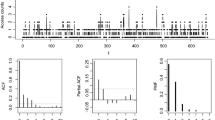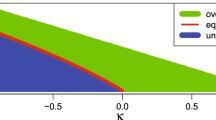Abstract
In this paper an overview is given over recent theoretical developments in autoregressive count time series. The focus is on generalized autoregressive models where the autoregressive structure is incorporated via a link function. Starting from an ordinary autoregressive model the difficulties in extending standard theory of statistical inference to count time series are highlighted. Special attention is given to the issues of ergodicity and asymptotic theory of estimation. Two main approaches are mentioned, a perturbation approach and the use of a weak dependence concept. The main emphasis is on the former. Linear as well as log-linear and nonlinear models are treated. It is argued that the developed theory forms a necessary basis for modelling and application of these count time series. The setting of the paper is one of simple models and conditional distributions of Poisson type. But it is claimed that the framework is general enough to handle many extensions with an accompanying flexibility in applications of these models.
Similar content being viewed by others
References
Andrews DWK (1984) Non-strong mixing autoregressive processes. Journal of Applied Probability 930–934
Berkes I, Horváth L, Kokoszka P (2003) GARCH processes: structure and estimation. Bernoulli 9(2):201–227
Bickel PJ, Bühlmann P (1999) A new mixing notion and functional central limit theorems for a sieve bootstrap in time series. Bernoulli 5(3):413–446
Brockwell PJ, Davis RA (1987) Time series: theory and methods. Springer, Berlin
Cox DR (1981) Statistical analysis of time series: Some recent developments [with discussion and reply]. Scand J Stat 8(2):93–115
Cui Y, Lund R (2009) A new look at time series of counts. Biometrika 96(4):781–792
Czado C, Gneiting T, Held L (2009) Predictive model assessment for count data. Biometrics 65(4):1254–1261
Davis RA, Dunsmuir W, Streett SB (2003) Observation-driven models for Poisson counts. Biometrika 90(4):777–790
Dedecker J, Prieur C (2005) New dependence coefficients. Examples and applications to statistics. Probab Theory Relat Fields 132(2):203–236
Dedecker J, Doukhan P, Lang G, León JR, Louhichi S, Prieur C (2007) Weak dependence: with examples and applications. Springer, Berlin
Doukhan P, Louhichi S (1999) A new weak dependence condition and applications to moment inequalities. Stoch Process Appl 84(2):313–342
Doukhan P, Neumann MH (2008) The notion of ψ-weak dependence and its applications to bootstrapping time series. Probab Surv 5:146–168
Doukhan P, Fokianos K, Tjøstheim D (2012) On weak dependence conditions for Poisson autoregression. Stat Probab Lett 82:942–948
Drost FC, Van den Akker R, Werker BJM (2008) Note on integer-valued bilinear time series models. Stat Probab Lett 78(8):992–996
Drost FC, Akker R, Werker BJM (2009) Efficient estimation of auto-regression parameters and innovation distributions for semiparametric integer-valued AR (p) models. J R Stat Soc, Ser B, Methodol 71(2):467–485
Fan J, Yao Q (2005) Nonlinear time series: nonparametric and parametric methods. Springer, Berlin
Ferland R, Latour A, Oraichi D (2006) Integer-valued GARCH process. J Time Ser Anal 27(6):923–942
Fokianos K (2012) Count time series models. In: Subba Rao T, Subba Rao S, Rao CR (eds) Handbook in statistics. Time series-methods and applications, vol 30, pp 315–348. Elsevier, Amsterdam
Fokianos K, Fried R (2010) Interventions in INGARCH processes. J Time Ser Anal 31(3):210–225
Fokianos K, Kedem B (2004) Partial likelihood inference for time series following generalized linear models. J Time Ser Anal 25(2):173–197
Fokianos K, Tjøstheim D (2011) Log-linear Poisson autoregression. J Multivar Anal 102:563–578
Fokianos K, Tjøstheim D (2012) Nonlinear Poisson autoregression. Ann. Inst. Stat. Math. (to appear)
Fokianos K, Rahbek A, Tjøstheim D (2009a) Poisson autoregression. Complete version available at www.amstat.org/publications/jasa/
Fokianos K, Rahbek A, Tjøstheim D (2009b) Poisson autoregression. J Am Stat Assoc 104(488):1430–1439
Fokianos K, Støve B, Tjøstheim D (2012) Approximate multivariate Poisson autoregression. Work in progress
Francq C, Zakoïan JM (2004) Maximum likelihood estimation of pure GARCH and ARMA-GARCH processes. Bernoulli 10(4):605–637
Franke J (2010) Weak dependence of functional INGARCH processes. Technical report, Working paper, University of Kaiserslautern
Heinen A (2003) Modelling time series count data: an autoregressive conditional Poisson model. In: CORE discussion Paper 2003062
Heinen A, Rengifo E (2007) Multivariate autoregressive modeling of time series count data using copulas. J Empir Finance 14(4):564–583
Jensen ST, Rahbek A (2004) Asymptotic inference for nonstationary GARCH. Econom Theory 20(06):1203–1226
Johnson N, Kotz S, Balakrishnan N (1997) Discrete multivariate distributions. Wiley, New York
Jung RC, Kukuk M, Liesenfeld R (2006) Time series of count data: modeling, estimation and diagnostics. Comput Stat Data Anal 51(4):2350–2364
Jung RC, Liesenfeld R, Richard JF (2011) Dynamic factor models for multivariate count data: an application to stock-market trading activity. J Bus Econ Stat 29(1):73–85
Kedem B, Fokianos K (2002) Regression models for time series analysis. WileyNew York
Letac G (1986) A contraction principle for certain Markov chains and its applications. In: Proceedings of the AMS-IMS-SIAM joint summer research conference held on June 17–23, 1984. Random matrices and their applications, vol 50, pp 263–276. American Mathematical Society, Providence
Li W (1994) Time series models based on generalized linear models: some further results. Biometrics 50(2):506–511
McCabe BPM, Martin GM, Harris D (2011) Optimal probabilistic forecasts for counts. J R Stat Soc, Ser B, Methodol 73:253–272
McCullagh P, Nelder JA (1989) Generalized linear models. Chapman Hall, London
McKenzie E (2003) Discrete variate time series. In: Handbook of statistics, vol 21, pp 573–606. Elsevier, Amsterdam
Meitz M, Saikkonen P (2008) Ergodicity, mixing, and existence of moments of a class of Markov models with applications to GARCH and ACD models. Econom Theory 24(05):1291–1320
Meyn SP, Tweedie RL (1993) Markov chains and stochastic stability. Springer, London
Neumann MH (2011) Absolute regularity and ergodicity of Poisson count processes. Bernoulli 17:1268–1284
Pham DT (1985) Some mixing properties of time series models. Stoch Process Appl 19:279–303
Rydberg TH, Shephard N (2000) A modelling framework for the prices and times of trades made on the New York stock exchange. Nonlinear and Nonstationary Signal Processing 217–246
Sandmann G, Koopman SJ (1998) Estimation of stochastic volatility models via Monte Carlo maximum likelihood. J Econom 87(2):271–301
Steutel F, Van Harn K (1979) Discrete analogues of self-decomposability and stability. Ann Probab 7(5):893–899
Straumann D, Mikosch T (2006) Quasi-maximum-likelihood estimation in conditionally heteroscedastic time series: a stochastic recurrence equations approach. Ann Stat 34(5):2449–2495
Streett S (2000) Some observation driven models for time series of counts. PhD thesis, Colorado State University, Department of Statistics
Teräsvirta T, Tjøstheim D, Granger CWJ (2010) Modelling nonlinear economic time series. Oxford University Press, Oxford
Tjøstheim D (1990) Non-linear time series and Markov chains. Advances in Applied Probability 587–611
Tong H (1993) Non-linear time series: a dynamical system approach. Oxford University Press, Oxford
Wang C, Li WK (2011) On the autopersistence functions and the autopersistence graphs of binary autoregressive time series. J Time Ser Anal 32:639–646
WeißCH (2008) Thinning operations for modeling time series of counts survey. AStA Adv Stat Anal 92(3):319–341
Zeger SL (1988) A regression model for time series of counts. Biometrika 75(4):621–629
Zeger SL, Qaqish B (1988) Markov regression models for time series: a quasi-likelihood approach. Biometrics 44(4):1019–1031
Acknowledgement
I am grateful to the editor and to three referees for a number of valuable remarks on an earlier version.
Author information
Authors and Affiliations
Corresponding author
Rights and permissions
About this article
Cite this article
Tjøstheim, D. Some recent theory for autoregressive count time series. TEST 21, 413–438 (2012). https://doi.org/10.1007/s11749-012-0296-0
Published:
Issue Date:
DOI: https://doi.org/10.1007/s11749-012-0296-0




